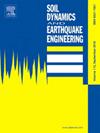液化土中盾构隧道结构纵向地震响应特征
IF 4.2
2区 工程技术
Q1 ENGINEERING, GEOLOGICAL
引用次数: 0
摘要
当盾构隧道位于可液化土层中时,地震荷载作用下土体应变的逐步累积和超孔隙水压力的积累和消散会影响隧道的地震响应。本研究利用OpenSees计算平台开发了一个完全耦合的固-液有效应力分析模型,以研究长延伸盾构隧道的地震响应。采用两种先进的可液化土和非液化土边界面塑性本构模型,模拟了不排水条件下土体的非线性行为。采用非线性弹簧模型模拟盾构隧道纵向节理的力学行为。考虑土体的非线性和滞回特性,利用所建立的模型对三种不同频率分量的地震动作用下盾构隧道结构的纵向地震响应特性进行了评价。结果表明,可液化土沉积物中饱和土与隧道结构的动力相互作用显著增加了隧道周围土壤的液化潜力。因此,液化土中隧道的地震反应比非液化土中隧道的地震反应更为明显。地震动谱特征对长延伸隧道结构的地震反应有很大影响。低频地震动对隧道力学性能有不利影响。此外,可以观察到,与拉伸载荷相比,由于混凝土的压缩刚度比连接螺栓的拉伸刚度高得多,因此在受压时,段环经历更大的内力。管片环内轴向力空间分布的变异性凸显了土体沿隧道纵轴方向非线性力学特性的影响。本文章由计算机程序翻译,如有差异,请以英文原文为准。
Longitudinal seismic response characteristics of shield tunnel structures in liquefiable soils
When shield tunnels are located in liquefiable soil deposits, the progressive accumulation of soil strains and the build-up and dissipation of the excess pore water pressure during seismic loading affect the seismic response of the tunnel. This study develops a fully coupled solid-fluid effective stress analysis model using the OpenSees computational platform to examine the seismic response of long-extended shield tunnels. Two advanced bounding surface plasticity constitutive models for liquefiable and non-liquefiable soils are utilized to simulate the soil nonlinear behaviors under undrained conditions. Nonlinear spring models are used to simulate the mechanical behavior of longitudinal joints in shield tunnels. The developed model is employed to evaluate the longitudinal seismic response characteristics of shield tunnel structures under three different ground motions with different frequency contents, considering the soil nonlinearity and hysteretic characteristics. The results reveal that the dynamic interaction between the saturated soil and the tunnel structure in liquefiable soil deposits significantly increases the liquefaction potential of the soil around the tunnel. Consequently, the seismic response of tunnels in liquefiable soils is more pronounced than in non-liquefiable soil deposits. The ground motion spectral characteristics greatly influence the seismic response of long-extended tunnel structures. Low-frequency ground motions have detrimental effects on the tunnel mechanical behaviors. Furthermore, it is observed that the segment rings experience greater internal forces when subjected to compression, compared to tensile loading due to the much higher compressive stiffness of the concrete compared to the tensile stiffness of the connecting bolts. Variability in the spatial distribution of the axial force within the segment rings highlights the influence of the soil nonlinear mechanical properties along the tunnel longitudinal axis.
求助全文
通过发布文献求助,成功后即可免费获取论文全文。
去求助
来源期刊

Soil Dynamics and Earthquake Engineering
工程技术-地球科学综合
CiteScore
7.50
自引率
15.00%
发文量
446
审稿时长
8 months
期刊介绍:
The journal aims to encourage and enhance the role of mechanics and other disciplines as they relate to earthquake engineering by providing opportunities for the publication of the work of applied mathematicians, engineers and other applied scientists involved in solving problems closely related to the field of earthquake engineering and geotechnical earthquake engineering.
Emphasis is placed on new concepts and techniques, but case histories will also be published if they enhance the presentation and understanding of new technical concepts.
 求助内容:
求助内容: 应助结果提醒方式:
应助结果提醒方式:


